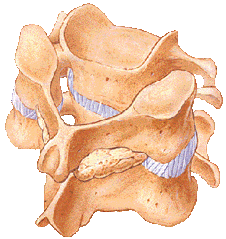Posterior Cervical Fusion
Rationale
The posterior cervical fusion is performed through an incision in the back of the neck. A posterior cervical fusion is used
to stop the motion between two or more vertebrae
to recreate the normal curve of the cervical spine and keep a spinal deformity from getting worse
to stabilize the spine after a fracture or dislocation of the cervical spine

Procedure
This surgery is done through the back of the neck. A bone graft is placed on the back surface of the problem vertebrae. During the healing process, the vertebrae grow together, creating a solid piece of bone. This type of fusion is used in the cervical spine for fractures and dislocations. It is also used to correct deformities in the neck.
The goal of spinal fusion is to stop the motion caused by segmental instability. This reduces the mechanical neck pain caused from too much motion in the spinal segment.
You may also hear the term anterior fusion. This procedure is commonly used to treat neck problems. The surgeon works from the front (anterior) of the neck. A bone graft is placed between two vertebral bodies (interbody area) to replace the disc that normally sits between them. During the healing process, the vertebrae grow together, creating a solid piece of bone. Learn more about the use of bone graft.
Related Document: Anterior Cervical Fusion
Related Document: Bone Grafts
Instrumented Posterior Cervical Fusion
A graft that is held tightly in place has a better chance of fusing the vertebrae together. To improve fusion, doctors commonly use metal plates, screws, and rods. These implants are referred to as instrumentation. Many different types of metal implants are used with the intent of maximizing healing of the fusion.
Bone heals best when it is held still-without motion between the pieces trying to heal. The healing of a fusion is no different than healing a fractured bone, such as a broken arm. However, the neck is one part of the body that is difficult to hold still, even with a brace worn around the outside of the neck. Wearing a brace for several months after the surgery can be uncomfortable.
When instrumentation is used to improve the success of a posterior fusion, metal rods or plates are attached to the bone structures in the back of the spine. Stainless steel or titanium cables can also be used. When doctors use this type of instrumentation, a brace may only be needed for a short period of time, or not at all.
 Menu
Menu









